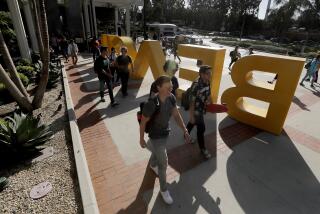VALLEY REPORT / SCHOOL LAYOFFS : Cutbacks Jeopardize Vocational, Elective Classes : District’s $341-Million Deficit Focuses Most Risk on Job-Oriented Instruction
- Share via
The Los Angeles Unified School District’s proposed teacher layoffs would mean a sharp reduction in popular vocational, homemaking and business skills classes--subjects educators say are the only reason many students stay in school.
Faced with a $341-million deficit for the 1991-92 school year, the district has sent layoff and transfer notices to about 200 of its more than 700 full-time instructors in homemaking, business skills and vocational arts, including agriculture, cabinetmaking, upholstery and other job-preparation courses.
Although district officials said they have decided to retain more than 40 of those positions, administrators predict that if the remaining teachers are released, schools next year would be unable to accommodate many of the thousands of students who sign up annually for typing, word processing, horticulture and dozens of other courses designed to prepare them for jobs after graduation.
“Kids don’t come to school for English and math,” said Nicholas Bradley, head of the English department at Sun Valley Junior High School. “They’re held in school by the electives. Without the electives, the dropout rate will just soar.”
Overall, nearly 1,000 district employees, including teachers, nurses, psychologists, counselors and librarians face layoffs and another 1,100 would be transferred. The Board of Education must make final layoff decisions by June 15, but the district could rescind the notices later if it gets a last-minute infusion of cash.
Confusion over teacher assignments in some vocational fields prompted district officials to keep about 40 of the teachers in auto mechanics, drafting, electronics and metals who had received layoff or transfer notices. Seven targeted positions in industrial crafts, food services, sheet metal and photography will also be retained, said Tom Killeen, a district personnel administrator.
However, other elective classes, including music, art, dance and physical education, are targeted for reductions.
Cutting electives would mean that thousands of students might never know that they have certain talents, administrators of the programs said. Students who could have been trained for careers in landscaping or clerical work would have to settle for menial, lower-paying jobs instead, they said.
“I think that a lot of students will lose out on the head start that I and other students have received,” said Carlos Warlick, 17, who has studied auto repair at North Hollywood High School. “They would probably just end up working at McDonald’s, just taking whatever’s there.”
Carlos, who works part time at an auto shop in Burbank, hopes to study auto mechanics after he graduates next month and then get a job with a shop specializing in off-road trucks.
Even students who pursue academic degrees will suffer if they can’t learn typing or word processing skills in high school, business education instructors said.
Programs that are just beginning to flourish after years of work would be mothballed or killed if the district goes ahead with the layoffs, instructors said.
For example, award-winning gardens and landscaping projects developed by students over five years in a horticulture program at Sun Valley Junior High School would succumb to neglect, instructor Win Hainbuch said. Nearly 1,300 students have taken Hainbuch’s classes, and many have gone on to high school horticulture classes and careers in landscaping.
Hainbuch was one of 17 agriculture teachers, out of a total of 50, who received notices that they could be laid off or transferred.
At high schools throughout the district, about 2,000 new typewriters will go unused if the district proceeds with plans to cut 68 business skills positions, about a third of the total, officials said. The district recently spent more than $2 million to buy about 5,000 typewriters.
Each year, more than 20,000 students take district-offered keyboarding and typewriting courses, said Maria Cueva, instructional adviser for the district’s business education program, which teaches basic business skills including typing, word processing, accounting and office technology. But if the layoffs are approved, nearly 7,000 students will not have the opportunity to learn typing in school next year, she said.
“It would be a crime to have all these classrooms with all that wonderful equipment and now the staff will be cut,” Cueva said.
More than 37,000 of the district’s 625,000 students take homemaking classes each year, said Kris Giving, district resource teacher in home economics education. About 4,000 students take home economics courses in parenting and child development, and 1,000 enroll each year in courses that prepare teen-agers for careers with children, such as nursery school instruction or day care, she said.
“It would be just devastating” if the district went ahead with plans to cut 37 teachers from the home economics program, Giving said.
Without proper training in high schools, students will arrive at college-level vocational programs unprepared, school officials said.
“Any time we lose a high school program, we suffer,” said Bart Trinchero, who teaches auto mechanics at Pierce College in Woodland Hills. “Even if a kid just learns a little bit and comes in here, it’s better than nothing. I think our country’s going to suffer eventually.”
The district said it had no choice but to warn employees of layoffs because the state is grappling with a $13-billion budget shortfall for the coming fiscal year. The notices were sent largely on the basis of seniority.
Students, meanwhile, worry that cutting electives will result in crowded classes in core subjects, making it harder to learn.
“You’ll have all these people goofing off,” said Sandy Bowles, 13, a seventh-grader at Sun Valley Junior High. “We won’t learn anything that we need to.”
The proposed cutbacks are just the latest in a series of reductions in elective programs that started with the 1978 passage of Proposition 13, said Gene Lew, the district’s industrial education adviser.
When Lew started out with the district in 1964 as a junior high metals instructor, most high schools had between six and nine full-time vocational or industrial arts teachers, he said. Today, high schools are lucky to have three vocational teachers.
Lew said that in addition to Proposition 13, the recent emphasis on returning to basic education--reading, writing and arithmetic--has led to cuts in elective programs. But that trend may be self-defeating, he said.
“If these electives are eliminated, that will limit the opportunities to try different things,” Lew said. “It gives them a chance to explore . . . and to find out what their interests are. It gives them opportunity to succeed in something that they like.”
More to Read
Sign up for Essential California
The most important California stories and recommendations in your inbox every morning.
You may occasionally receive promotional content from the Los Angeles Times.










